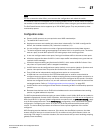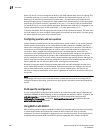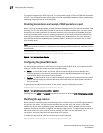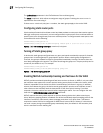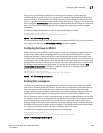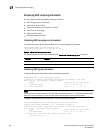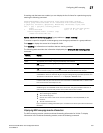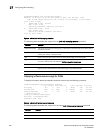
PowerConnect B-Series FCX Configuration Guide 899
53-1002266-01
Configuring MLD snooping
27
Every group on a physical port keeps its own tracking record. However, it can track group
membership only; it cannot track by (source, group). For example, Client A and Client B belong to
group1 but each is receiving traffic from different sources. Client A receives a traffic stream from
(source_1, group1) and Client B receives a traffic stream from (source_2, group1). The device waits
for the configured leave-wait-time before it stops the traffic because the two clients are in the same
group. If the clients are in different groups, the waiting period is ignored and traffic is stopped
immediately.
To enable tracking and fast leave for VLAN 20, enter the following commands.
PowerConnect(config)#vlan 20
PowerConnect(config-vlan-20)#mld-snooping tracking
Syntax: [no] mld-snooping tracking
The membership tracking and fast leave features are supported for MLDv2 only. If a port or client is
not configured for MLDv2, the mld-snooping tracking command is ignored.
Configuring fast leave for MLDv1
When a device receives an MLDv1 leave message, it sends out multiple group-specific queries. If
no other client replies within the waiting period, the device stops forwarding traffic to this port.
Configuring fast-leave-v1 allows the device to stop forwarding traffic to a port immediately upon
receiving a leave message. The device does not send group-specific queries. It is important that no
snooping ports have multiple clients. When two devices connect, the querier device should not be
configured for fast-leave-v1 because the port to the non-querier device could have multiple clients.
The number of queries and the waiting period (in seconds) can be configured using the ipv6
mld-snooping leave-wait-time command. The default is 2 seconds. To configure fast leave for
MLDv1, use commands such as the following.
PowerConnect(config)#vlan 20
PowerConnect(config-vlan-20)#mld-snooping fast-leave-v1
Syntax: [no] mld-snooping fast-leave-v1
Enabling fast convergence
In addition to periodically sending general queries, an active (querier) device sends out general
queries when it detects a new port. However, since it does not recognize the other device port-up
event, the multicast traffic might still use the query-interval time to resume after a topology
change. Configuring fast-convergence allows the device to listen to topology change events in L2
protocols, such as spanning tree, and send general queries to shorten the convergence time.
If the L2 protocol is unable to detect a topology change, the fast-convergence feature may not work.
For example, if the direct connection between two devices switches from one interface to another,
the rapid spanning tree protocol (802.1w) considers this an optimization action, rather than a
topology change. In this case, other devices will not receive topology change notifications and will
be unable to send queries to speed up the convergence. The original spanning tree protocol does
not recognize optimization actions, and fast-convergence works in all cases.
To enable fast-convergence, enter commands such as the following.
PowerConnect(config)#vlan 70
PowerConnect(config-vlan-70)#mld-snooping fast-convergence
Syntax: mld-snooping fast-convergence



